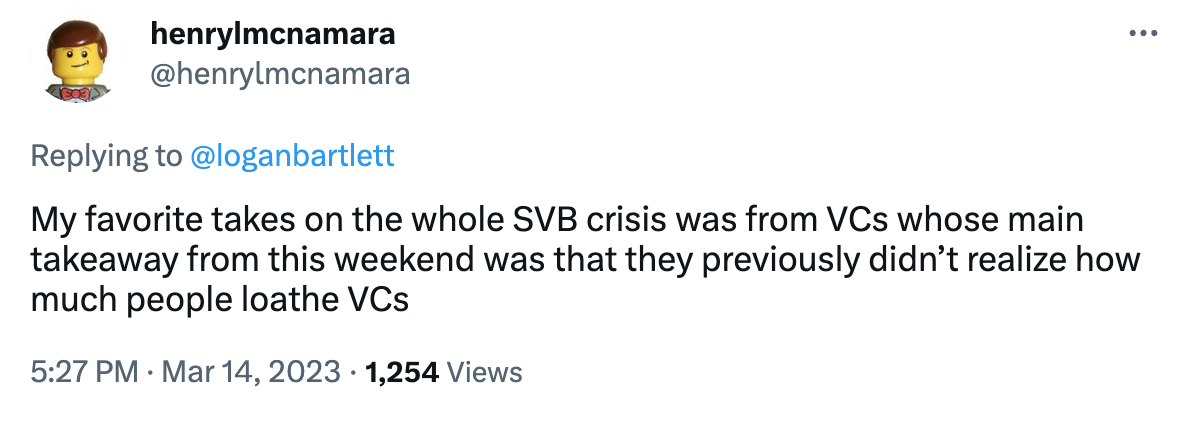The Obligations of Innovation
Silicon Valley is just a sub-2000 square mile patch of land in Northern California, of equivalent size to the state of Delaware. A small plot of relatively unremarkable topography. Silicon Valley is also the heart, headquarters, and catalyst for the startup ecosystem that (now) powers the US economy. Seven of the top 10 Fortune 500 companies are technology companies, and though not all were founded in the Valley, each has spiritual roots there.
Silicon Valley effectively represents an ethos that undergirds the entirety of the technology and startup ecosystem - the Innovation Economy - in California, across the US, and around the world. Though its influence has arguably never been greater, all is not right in the Valley. Internally, we’ve seen contagious layoffs, mass employee unease, the implosion of the region’s eponymous bank, and the large-scale pullback of investor “dry powder” that will inevitably result in the closure of many venture firms.
Externally, lawmakers from both sides of the aisle have taken aim at “Big Tech” (whatever that means), while the populous has seemingly trended toward apathy or outright derision:

I’ve personally spent the past decade-plus in the Silicon Valley ecosystem (albeit from Los Angeles, with many a day trip to the Bay), and for several years I’ve witnessed a growing disconnect between the stated ethos of the Valley and its actual behavior.
On the one hand, this may just be a typical manifestation of reaching the end of a technological epoch. Using Carlota Perez’s framework here, we are probably in the “maturity” phase of the Information Technology age. On the other, this unrest does not appear to be a simple response to macro conditions.
Instead, the very strengths and virtues that represent the Silicon Valley ethos, and which have so successfully built the technology that’s powered our economy to incredible highs post-WWII, have seemingly also created negative externalities that have not been properly addressed, individually or collectively. That is, the Valley’s towering strengths are metastasizing.

Concentration of Talent
“I'm not claiming of course that every startup has to go to Silicon Valley to succeed. Just that all other things being equal, the more of a startup hub a place is, the better startups will do there.” - Paul Graham
Even in these post-pandemic days, in which “remote work is the best work” fantasies flit innocuously into the ether, there is tangible, measurable value in working within driving distance of Silicon Valley. It is a (largely) self-sustaining ecosystem with the highest concentration of investors, technical talent, and experienced scale operators in the world.
When a startup closes, its employees quickly migrate to other similar companies (at least until recently). When a startup exits, its newly-baked millionaires reflexively recycle portions of their wealth back into the ecosystem as angel investments, to catalyze the continuation of the startup feedback loop. When the Valley is humming, you really can feel the energy cascading between the logo-clad high-rises. But as is often the case within insular communities, Silicon Valley suffers from an insider/outsider problem.
Bud Tribble, VP of Software at Apple at the time, described in 1981 that Steve Jobs’ charisma created a “reality distortion field”:
the “ability to convince himself, and others around him, to believe almost anything with a mix of charm, charisma, bravado, hyperbole, marketing, appeasement and persistence”.
Though he didn’t “found” Silicon Valley, Jobs has long been the industry’s paragon, a sincere and vicious figure who inspired thousands to turn their garage-initiated hobbies into fantastical technical achievements. But this reality distortion field has metaphorically ossified over the Valley, with walls so thick that outside thoughts cannot penetrate and inside thoughts simply reverberate throughout the domed inhabitants; a beautiful, transparent echo chamber.

Within such a vessel, intellectual inbreeding mutates and morphs truths into dogmas that often contradict the initial inspirations on which these beliefs were originally based. It’s this bubble that influences its otherwise hyper-intelligent inhabitants to publicly lament (mostly on Twitter) that members of the non-Valley tribe are out to get them.
Are there actually enemies of “Big Tech”? Sure. But it is a dereliction of duty to place the primacy of blame on others when so many of the issues here are self-wrought. For one, we leftists in the most prominent leftist state in the union must admit that:
- Large swaths of the country do not share our (often incoherent) beliefs, and this makes them neither wrong nor lesser.
- Many of the beliefs we hold so dear will necessarily be seen as abhorrent when future humans study our present as their past.
Echo chambers reinforce cognitive homogeneity, an actual enemy of innovation. It’s this very mechanism that led to Palmer Luckey’s ouster from Facebook and to his further castigation by daring to create technology for the DoD. It’s this mechanism that implicitly (and occasionally explicitly) prohibits non-liberal thought. There’s a reason why the only prominent non-closeted Republicans are wealthy enough to not care about the blowback of such an “awful admission”.
Second, Silicon Valley must acknowledge that it does, whether intentionally or not, actively harm the career prospects of non-coastal workers. Let me call out immediately that this is not some Andrew Yang-flavored “robots and AI will take all of the jobs” rant. But Silicon Valley creates technology, and technology is a collection of tools that provide humans with far greater leverage - to literally do more with less. Technology’s job is, in the narrowest sense, to eliminate certain types of work from the human condition.
Though these results are largely net positive for humanity, they are far from equally distributed. Those unequally harmed by technological advancement are non-coincidentally heavily concentrated in so-called red states. Even if these are just hyperbolized (and often politically catalyzed) perceptions, they are reinforced by the reality of tech’s geographic concentration on the coasts. When oil companies dominated the top of the S&P, Valley power brokers could remain largely hidden in their NorCal fortresses, impregnable by broader societal impacts and obligations.
No longer. The spotlight is on, and it’s time to stop bemoaning the “unfair treatment” and instead learn to engage with critics large and small. The social and political benefits are obvious, but I would posit that correcting tech’s coastal myopia will yield greater fiscal returns as well.
When you’re a hammer…
“Software is eating the world”- Marc Andreessen
When Marc Andreessen originally made this quip in the before times of 2011, it was both a provocation and a call to arms. Now, it’s simply fact. Although the Valley originated with hardware, it is the coded abstractions sitting atop these massively scaled binary micro-switches that truly dominate technology today and are sweeping through every industry on the planet.
Software is written by (software) engineers, and this discipline thus sits atop the hierarchy of roles. It is quite rare that a new technology startup is founded without a “technical co-founder”. Indeed, most VCs bristle at the notion of funding a software startup without an engineer in the founding team. With engineering as the alpha discipline, and with the most important roles (founders) dominated by engineers, it necessarily follows that the Valley will primarily seek out interesting technical problems to solve.
This is not always an optimal approach.

Let’s look at a contrasting set of examples within my beloved video game industry, starting with the Game Boy. In the early 1980s, Nintendo adopted a development approach called “lateral thinking with withered technology”. That is, they institutionalized a preference for the oldest but most stable technology available, applied in a new context.
Why not cutting edge? Why adopt this black and white-adjacent (really green) screen rather than color?

It’s because Nintendo wasn’t optimizing for complexity, for the cutting edge. They weren’t optimizing for their own self-interests, for intellectual satisfaction. No, they were optimizing for the customer experience, for “portable, reliable, affordable fun”. That is, they understood that:
- A tight form factor and nuclear-resistant outer shell meant that gamers could, for the first time, bring their console experience on the go (“portable).
- Older, less cutting edge components are far more stable and durable, so the device will effectively always work (“reliable”).
- Cheaper components yield a cheaper device which allows more people to play (“affordable”).
- Lower fidelity, non-color screens allowed for far better battery life, which enabled users to play for much longer without being interrupted, and playing more is preferred over playing less (“fun”).
Now to the polar opposite approach - Google’s Stadia. Cloud gaming had been toyed with for years, as both Gaikai and OnLive had launched but failed to gain traction. But cloud computing (horsepower, latency, and costs) had Moore’s Law-ed its way into viability in the intervening years, and Google had for 15 years successfully operated the largest video streaming platform (YouTube).
Google is a “company of engineers” that generally prefers the complex, intellectual challenges I’ve already referenced. They correctly assessed that they could technically bring down latency far enough (under 60ms) that most games would feel indistinguishable from a standard console experience. And so they brought their “unconsole” to market with this singular innovation - low latency streaming.
How did they each fare?
The Game Boy ultimately sold almost 120M units, saved Nintendo, and frankly rescued the gaming industry from its own nuclear winter.
Google Stadia? Less than 1M units sold and shut down after a little more than three years of operation.
One could argue that the ecosystems in each time period are the actual reason for the success gap here - Nintendo launched its product into a market with effectively no competition, whereas Google had massively successful incumbents (Sony, Microsoft) to contend with.
Fair, but one could also argue the opposite - that Nintendo launched its product into a flaccid market (inflation-adjusted $8B), whereas Google launched into a massively scaled market ($92B).
The pithy, but IMO more convincing argument, is that Google, as they often do, prioritized solving a difficult technical problem rather than an actual customer need.
Their technical myopia prevented the prioritization and building for simple customer-focused questions like:
- What types of customers is this meant for- current gamers (who already own consoles) or new gamers?
- Is the approach here complementary to existing consoles? Is it a replacement?
- Is maintaining the transactional revenue model actually better than subscription?
- What types of games are best suited (and not) for this service?
Silicon Valley’s patron saint once said:
“Technology alone is not enough—it’s technology married with liberal arts, married with the humanities, that yields us the results that make our heart sing.”
Humans are not simply technical problems to be solved, and understanding technology is not equivalent to understanding humans. Technology must be useful, not simply intellectually interesting, because technology is a means to an end, not the end unto itself.
Here the sin is one of omission not commission; the choices not made, the invisible counterfactuals, that have immeasurable yet clearly significant impact. This is not a challenge unique to the tech industry, but given the ascendance of technology as the world’s dominant industry, coupled with the fact that software is indeed eating the world, the questions not asked - the problems not chosen to solve - have far greater negative externalities for Silicon Valley.
Silicon Valley is, unequivocally, humanity’s largest innovation engine, and if it chooses not to solve a given problem - because it’s not obviously technical, that it’s too “simple”, or that it (heaven forbid) requires interaction with other “lesser” institutions like government, education, etc - US society and humanity writ large suffers.
Powered by Optimism
“When you are the leader of a company (or anything else), you have to lead with optimism, enthusiasm, and positive energy.” Fred Wilson
Startups specifically and Silicon Valley more broadly are fueled not by capital but by optimism. Every startup’s pitch, especially its first, is pretty outlandish. In stark contrast to so much of finance, the correct venture response to such a pitch is not “how could this possibly work?” but “what if it does work?” Innovation by definition must buck the status quo, requiring a reorientation of our fundamental perceptions about how the world works.
Investing in innovation is thus difficult for three major reasons:
- Most humans are simply not wired to see, let alone understand, a counterfactual reality.
- Most ideas are quite dumb!
- We cannot a priori identify with any modicum of certainty which ideas are actually dumb or are simply part of this counterfactual (better) future state of reality.
Thus, optimism - there’s simply no other feasible orientation for a person (whether investor or founder) who knows that the actual probability of success is miniscule. Logically the only reason such a low success rate retains viability is because of the power law distribution of returns. And yet…
Like each of the strengths we’ve already discussed, left unchecked they tend toward spoilage. Downside risk mitigation isn’t fun, but neither were vegetables before we made them fashionable. Building something because “I can raise money for it” and then wrapping a mission around it may in fact make you wealthy, perhaps obscenely wealthy, but is it healthy? Is it virtuous? Does it help literally anyone other than the small cadre of founders and investors who won the lottery and called it skill?
Unfettered optimism is not just a descriptor but is actually codified in startup valuations. To be clear, valuation is an absolutely necessary piece of the startup life cycle, but a precise instrument it is not. Valuations of companies that have not yet achieved product-market fit are less this:

and more this:

Early-stage valuations are arbitrary precisely because they are, unlike any other asset class, completely dependent on Intangibles. We further codify this optimism-as-valuation in standard VC fund performance metrics. Without boring you with the various acronyms and calculations, there are two primary ways that fund returns are calculated:
- Actual cash returned to investors from a liquidity event (e.g., company sale or IPO)
- Potential future returns to investors, based on the fund’s ownership stake at the most recent valuation
Because lemons ripen early in venture, the smaller actual investor returns must by definition lag greater potential returns, with most of the value of a given fund often accruing 7-10 years after the fund launched. It is almost never the case that a fund manager will wait until the fund’s returns have completed, or even until investors are “in the money”, to raise a subsequent fund.
That is, a fund manager is actually incentivized to build a portfolio on hyperbolic optimism (“hype”), ostensibly a momentum strategy2, because it will radically increase the valuation velocity and thus the potential value of the current fund. At some point, poor actual returns may come calling, but the ability to ride optimism (in the form of unearned valuations) across multiple funds is very real, especially when social relationships between GPs and LPs routinely override actual fund returns.
In a decade-long period of historically low rates and dump trucks of institutional capital looking for new sources of alpha, new venture firms sprung up like lemonade stands on a hot summer day, willing to invest in every white male with a pulse (and occasionally a few others).
In such an environment, bereft with speculators and grifters and faux-intellectuals hailed as oracles, the predictable result is that even the most obvious and ludicrously dumb ideas can be rationalized, and funded, at scale:
“Sometimes a half-dozen nearly identical companies show up promising to have a man on a bike bring you a pint of ice cream at any time of day, in 10 minutes, or eight, or six, and then a few months later they are all gone.”
Optimism is the rocket fuel of innovation, but it burns hot and in just one direction. We certainly don’t need a wave of skeptics or cynics here, but it would be healthy to add a dash of pragmatism to the Valley’s flavor of optimism.
Chips on Shoulders
“One of the historically common characteristics of people in tech is that many of them have a sizable chip on their shoulder. They were often the nerdy kids in school, marginalized or bullied for being different (I was definitely not the “cool kid” growing up).” - Chris Neumann
So many flock to Silicon Valley precisely because of its open embrace of the weird and the different, tying back to its geographical and temporal overlap with the countercultural movements of the 60s. These innovation migrants arrived with plenty of personal (figurative) baggage - often synonymous with burden, but when focused appropriately, actually serves as ambition fuel. As deep tech investor Josh Wolfe likes to say:
“Chips on shoulders put chips in pockets.”
Or, if you’re more of a visual learner:

For the last 60 years, Silicon Valley has used its NorCal-sized chip to fuel its rise from a small band of traitorous outsiders to the global hub of the Innovation Economy. That feeling of not belonging, of being the nerdy underdog, still remains, but it no longer reflects reality:
“Unfortunately, many people in tech haven’t fully accepted that they’re now at the top of the mountain. Far too many billionaire founders and influential VCs continue to act as if they’re the underdogs. They genuinely believe that they are still David fighting against Goliath.”
The Valley has transformed, but it has thus far failed to accept the mirror’s reflection of reality:

One might argue that this is not a problem; that the industry’s results have been great and to remove a core piece of ambition would necessarily harm global productivity. I’m not at all convinced. Accepting the Valley’s status shift does not require a diminishment of ambition, nor a pull back on innovation. No, what I’m advocating here is much needed self-reflection to better ground just how privileged it is:
“When I joined Aster Data as the company’s first employee in 2005, I took a big risk. But I also knew that if things didn’t work out, I could walk across the street to Google, Apple or a host of other companies and get an incredibly well-paying job in a matter of weeks. The worst case scenario was never going to be that bad. That is the absolute definition of privilege. The fact of the matter is people in tech are elite. And if you ask most of Middle America, we’re completely out-of-touch.”
Privilege left un-investigated and unchallenged, coupled with two-sigma intelligence and incredible wealth, unfortunately and inevitably results in tone deaf entitlement:

I’m reminded here of Hemingway’s (perhaps self-serving) take on the burden of intelligence:
“An intelligent man is sometimes forced to be drunk to spend time with his fools”
Remember that Michael Lewis intended for Liar’s Poker to be an insider’s cautionary tale regaling the excesses of a decade. Instead it became a catalyst for young men (always men) to join these very firms, clutching Liar’s Poker like a financial bible worshiping false gods like:

One needn’t squint too hard to see the resemblance between good ol’ Gordon and today’s Silicon Valley. Whereas the bankers and hedge fund managers would pridefully celebrate their purely fiscal motivation for their 80 hour weeks, the Valley instead pushes this “Greed is Good” ethos into the back office and emblazons a mission statement at the top of the balance sheet.
The net result of this unexamined privilege and ascendance is not just greed masquerading as mission but in mass-scale unhappiness:
“They prosper and prosper and speak bitterly about how unappreciated they are, but they seem somehow incomplete. It's as if the money had crowded something important out.” David Roth
I’ll admit that I’m concerned, about…
- An industry that catalyzes our global Innovation Economy maintaining its obviously false belief that it is an aggrieved party.
- The Valley’s role (however unwilling) in the growing economic divide.
- The psychological toll that wealth without purpose has on many of our brightest minds.
All for One and One for All(?)
I’ve spent much of these two pieces extolling the benefits and virtues of innovation that leverages collective action to power the world’s economies. When the industry does well, like in the most recent decade-long bull run, all constituents benefit, collectively. That is, it is not individuals but the “scenius” of the Valley that truly makes it hum. And yet, it’s possible that this “unity” may simply reflect the positive slope of returns. Ben Thompson writes:
“I assumed that Silicon Valley broadly was in the business of taking care of their own. … [But] the bank run that resulted made it clear that everyone, from venture capitalists to the startups they advised, [was] solely concerned about their own welfare, not about the ecosystem as a whole.”
Matt Levine responds:
“Thompson’s argument in that post is that Silicon Valley used to be an iterated game among repeat players: Venture capitalists had long careers and made many investments and would benefit way more from building a good reputation and helping the overall startup ecosystem than they would by maximizing their winnings on any one deal. But, he argues, as startup exits and venture funds have gotten bigger, “success became less about a series of victories and more about going big or going home,” and that cooperative ethos has weakened.”
He continues:
“It is funny to think of tech founders and venture capitalists as creatures of myopic self-interest, while bank CEOs are the generous altruists, but the point is the bankers don’t have a choice. Banking is a necessarily social business, banks are interconnected, and the best and biggest bank is only as good as confidence in the broad banking system. You can’t “go big or go home”; even Jamie Dimon has to care about the health of his less competent competitors.”
Building community, and more broadly fostering a healthy ecosystem, is a noble pursuit that we should seek out, celebrate, and ultimately incentivize. Industries are economic ecosystems, after all - loose collections of people, companies, and investors that broadly solve similar types of problems. And these ecosystems provide communal rewards to its members for its outputs:
- A just-graduated engineer receives a $250k base salary not because he’s earned it, but because the collective output of engineering as a discipline has raised the collective value of such a credential.
- A mediocre company doesn’t earn unicorn status solely on its own merits (if there are even are any) but because the collective output of corporate exits enables such a valuation multiple.
That is, there is a COLLECTIVE benefit to participating in an ecosystem like the tech industry, or the Innovation Economy, and no individual is ever responsible for that benefit nor should be able to claim the majority fruits of those benefits. I’ll admit that as a recent “convert” to Georgism, my brain is acutely tuned to the systems and incentives we use (or don’t) to encourage collective rewards for collective actions. I suspect that few would argue with either of the collective benefits I just described, at least as they pertain to others.
Turn that same question to his own compensation, however, and he will almost certainly hem and haw about all of the work he’s put in, his own skills, and call out the absurdity of any supposition that he is not solely responsible for his compensation. We are an individualistic nation, and I am myself more individualist than collectivist. But the Libertarian individualism that colors so much of Silicon Valley thoughts and behaviors today takes these views to an extreme that are not only prima facie incorrect but also counterproductive to the Valley’s constituents.
The reality is that Silicon Valley works because it aggregates the most incredible collection of individuals on the planet, catalyzes innovation capitalism at scale, and then distributes these benefits to its constituents - unequally of course (a topic for another post), but distributed to the collective nonetheless. Silicon Valley is today a scenius, but this status is not default alive - without the appropriate watering and pruning, it will erode.
Conclusion
That Silicon Valley is so vital to the growth of the US economy, to America’s long-term prospects, and, frankly, to humanity’s, is unassailable. Nor can one question that the valley has been a massively successful engine of both technological development and wealth generation. But the very characteristics that have catalyzed its ascent are also directly responsible for much of the unease within and the derision leveled against the Valley by its denizens and its critics alike.
The technology industry owes its roots to all of the Homebrew Computer Clubs of yore, but those days have long since passed. The Valley is no longer a nerd collective tinkering in garages but an ecosystem governed by capitalist kings. This newfound wealth and power comes with obligations that extend far beyond the technology it creates or the wealth that it generates; ethical and moral obligations that require reflection and accountability for how it treats its own and all others.
Some may argue, perhaps persuasively, that this is not the job of industry; that moralizing and philosophizing should be left to those who don’t build. I am not such an advocate. Capitalism divorced from meaning is a perilous endeavor, and certainly not one that we should strive to reinforce.